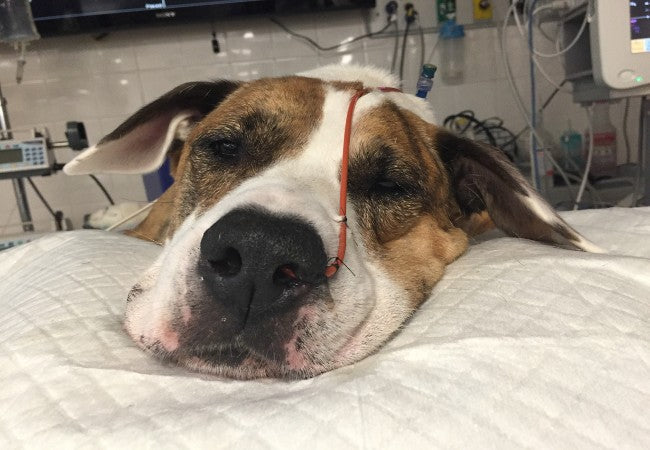Veterinary Guide to Canine Hypoalbuminemia 2025 🐶💧🩺

In this article
Veterinary Guide to Canine Hypoalbuminemia 2025 🐶💧🩺
By Dr. Duncan Houston BVSc
🧬 What Is Hypoalbuminemia?
Hypoalbuminemia is a state of abnormally low blood albumin, usually < 2.5 g/dL, that reduces oncotic pressure and can lead to edema, effusions, and systemic illness. Albumin is a negative acute-phase protein, so it may drop in inflammation even without severe underlying disease.
👥 Which Dogs Are Affected?
- Critically ill dogs with liver, kidney, or GI disease.
- Dogs with protein-losing nephropathy (PLN) or enteropathy (PLE), liver insufficiency or vascular disease.
- Inflammatory or infectious conditions causing albumin loss or redistribution.
- Mild cases can occur with malnutrition or acute inflammation but rarely drop below 2.1 g/dL.
⚠️ Signs & Complications
- Peripheral edema, ascites, pleural effusion—transudative fluid from reduced colloid pressure.
- Effusions can impair breathing, mobility, wound healing, and tissue perfusion.
- Other non-specific signs: lethargy, inappetence, weight loss, weakness.
- Concurrent issues: low ionized calcium, zinc deficiency, altered drug binding.
🔍 Diagnostic Evaluation
- History & Physical: note edema patterns, possible protein loss, underlying disease.
- Bloodwork: CBC, biochemistry—albumin, globulins, ALT/ALP, BUN; inflammation or organ dysfunction clues.
- Urinalysis + UPC: check proteinuria—UPC > 5 suggests PLN; rule out hematuria or infection.
- Imaging: abdominal and thoracic ultrasound/x-ray to detect effusions or liver/kidney abnormalities.
- Specific tests: bile acids, liver function, fecal α₁-antitrypsin for PLE.
- Biopsies: liver, kidney, or intestinal tissue—if indicated, to confirm diagnosis.
🛠️ Treatment Strategies
1. Target the Underlying Cause
- PLN: immunosuppression (steroids, ACE inhibitors) after infectious causes ruled out.
- PLE/IBD/lymphangiectasia: steroid therapy, dietary management—novel/hypoallergenic/low-fat.
- Liver disease/shunts: treat infections, chelate copper, or surgically correct shunts.
- Vascular/effusive disease: manage peritonitis, vasculitis, chylous or pyothorax conditions.
- Inflammation caused hypoalbuminemia: treat infection/inflammation and provide supportive care.
2. Manage Edema & Effusions
- Drain effusions as needed and monitor regularly.
- Use colloids (hetastarch) cautiously to boost oncotic pressure.
- Albumin infusions reserved for refractory cases—safe canine albumin agents exist; human/bovine products risk reactions.
3. Supportive Nutritional Care
- Enteral nutrition early in critical cases; consider parenteral support if needed.
- Adjust diet based on condition: renal-friendly for PLN, hypoallergenic/low-fat for PLE, hepatoprotective for liver disease.
- Watch for micronutrient deficiencies and supplement accordingly.
4. Regular Monitoring
- Recheck albumin, kidney/liver values, UPC, and clinical signs every 2–4 weeks early, then as treatment allows.
- Image effusions and organ status periodically.
- Adjust treatment based on lab trends and clinical response.
📈 Prognosis
- Cause-dependent; PLN and PLE can improve with targeted treatment.
- Severe liver or renal failure has more guarded prognosis.
- Albumin below 2.0 g/dL increases the risk of edema-related complications and poorer outcomes.
- Supplemental albumin may help acute critical cases but doesn’t improve long-term outcomes if the underlying disease untreated.
📱 Ask A Vet Telehealth Integration
- 📸 Upload labs, UPC results, and effusion images for remote vet review.
- 🔔 Medication/diet reminders, scheduled UPC or albumin retesting notifications.
- 🩺 Virtual check-ins: monitor edema, breathing, appetite, vitals.
🎓 Case Spotlight: “Bella” the Cocker Spaniel
Bella, a 5-year-old Cocker, presented with ascites and edema. Labs showed albumin 1.8 g/dL, UPC = 6.2. Diagnosis: PLN. Treatment included prednisone taper, ACE inhibitor, renal diet. Colloid bolus given once. Ask A Vet coordinated telehealth lab reviews, diet reminders. Within 2 months, albumin normalized to 2.8 g/dL and edema resolved 🐾.
🔚 Key Takeaways
- Hypoalbuminemia is a sign, not a disease—investigate underlying cause (renal, GI, hepatic, vasculature, inflammation).
- Edema/effusions arise from low oncotic pressure; treat symptomatically and address protein loss.
- Therapy includes disease-specific treatment, nutrition, supportive care, and monitoring.
- Albumin infusions are risky and rarely beneficial long-term; reserved for critical cases.
- Ask A Vet telehealth ensures continuity: lab interpretation, diet, fluid control, supplement delivery, and remote tracking 📲🐕
Dr Duncan Houston BVSc, founder of Ask A Vet. Download the Ask A Vet app to help your dog with hypoalbuminemia—receive lab reviews, fluid management plans, diet guidance, medication reminders, and long-term monitoring for healthier outcomes 🐶📲






